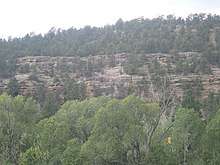Alamitos Formation
The Alamitos Formation is a geologic formation exposed in the southern Sangre de Cristo Mountains of New Mexico. It preserves fossils dating back to the late Pennsylvanian to early Permian periods.[1]
| Alamitos Formation Stratigraphic range: Pennsylvanian to Permian | |
|---|---|
 Alamitos Formation at one of its reference sections | |
| Type | Formation |
| Underlies | Sangre de Cristo Formation |
| Overlies | La Pasada Formation, Porvenir Formation, Flechado Formation |
| Thickness | 645–1,828 ft (197–557 m) |
| Lithology | |
| Primary | Sandstone |
| Other | Limestone, shale |
| Location | |
| Coordinates | 35.619°N 105.690°W |
| Region | New Mexico |
| Country | United States |
| Type section | |
| Named for | Alamitos Canyon |
| Named by | P.K. Sutherland |
| Year defined | 1963 |
 Alamitos Formation (the United States)  Alamitos Formation (New Mexico) | |
Description
The formation consists mostly of sandstone and conglomerate (50%) with lesser amounts of limestone (21%) and shale and siltstone (29%). The limestone tends to be more abundant in the upper third of the formation, though the formation shows considerable lateral variation.[2]
The formation is underlain by the La Pasada Formation in the southeastern Sangre de Cristo Mountains with the contact placed at an abrupt transition from limestone to arkosic sandstone and conglomerate. In the southern Sangre de Cristo Mountains, the underlying formation is the Porvenir Formation, while to the north the underlying formation is the Flechado Formation.[3] The Alamitos Formation is overlain by the Sangre de Cristo Formation with the contact placed at the uppermost well-developed limestone bed.[2]
 Alamitos Formation exposed in a road cut north of Pecos
Alamitos Formation exposed in a road cut north of Pecos
Fossils
The formation contains fossils ranging in age from middle Desmoinesian (Moscovian) to early Wolfcampian (Asselian). These include the fusilinids Beedeina, Tricites, and Schwagerina.[1] The formation also contains abraded fragments of crinoids and bryozoans.[2]
History of investigation
The formation was first named by P.K. Sutherland in 1963, who considered it correlative with the upper part of the Madera Formation.[2] However, in 2004, Kues and Giles recommended restricting the Madera Group to shelf and marginal basin beds of Desmoinean (upper Moscovian) to early Virgilian age, which excluded the Alamitos Formation.[3] Lucas et al. also exclude the Alamitos Formation from the Madera Group.[4]
Footnotes
- Baltz and Myers 1999
- Sutherland 1963
- Kues and Giles 2004, p.100
- Lucas et al. 2016
References
- Baltz, E.H.; Myers, D.H. (1999). "Stratigraphic framework of upper Paleozoic rocks, southeastern Sangre de Cristo Mountains, New Mexico, with a section on speculations and implications for regional interpretation of Ancestral Rocky Mountains paleotectonics". New Mexico Bureau of Mines and Mineral Resources Memoir. 48. Retrieved 29 July 2020.
- Kues, B.S.; Giles, K.A. (2004). "The late Paleozoic Ancestral Rocky Mountain system in New Mexico". In Mack, G.H.; Giles, K.A. (eds.). The geology of New Mexico. A geologic history (Special Volume 11). New Mexico Geological Society. pp. 95–136.
- Lucas, Spencer G.; Krainer, Karl; Vachard, Daniel (2016). "The Pennsylvanian section at Priest Canyon, southern Manzano Mountains, New Mexico" (PDF). New Mexico Geological Society Field Conference Series. 67. Retrieved 11 June 2020.
- Sutherland, P.K. (1963). "Paleozoic rocks" (PDF). In Miller, J.P.; Montgomery, Arthur; Sutherland, P.K. (eds.). Geology of part of the southern Sangre de Cristo Mountains, New Mexico. New Mexico Bureau of Mines and Mineral Resources Memoir 11. pp. 22–44. Retrieved 29 July 2020.